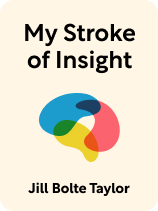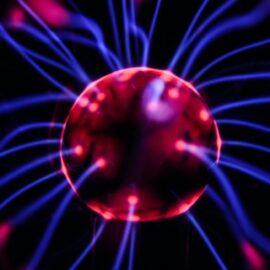

This article is an excerpt from the Shortform book guide to "My Stroke of Insight" by Jill Bolte Taylor. Shortform has the world's best summaries and analyses of books you should be reading.
Like this article? Sign up for a free trial here.
What’s the difference between the left brain and the right brain? How do they work together?
The two hemispheres of the brain work in unison. But each one has its own abilities, perception, and personality. Neuroanatomist Jill Bolte Taylor provides a simple explanation of the left brain and right brain in her book My Stroke of Insight.
Keep reading to understand the two sides of the brain.
The Two Hemispheres of the Brain
When functioning normally, the two hemispheres of the brain are an inseparable whole. And, every cognitive activity—such as reading, talking, painting, or driving—takes place in both hemispheres, with each side contributing to the thought process in a different way.
According to Taylor, you experience the differences between your brain’s hemispheres as different sides to your personality. The left brain is the seat of logic and judgment, while the right brain is the home of intuition and empathy. Here, we’ll consider the specifics of how each hemisphere contributes to cognition and then focus on how the two halves work in tandem.
As information flows in from your senses, the right brain collates all that data into a full sensory picture of your surroundings in the present moment. Taylor claims that, to the right hemisphere, there’s no sense of time—everything is now. While your right brain lives wholly in the moment, it also perceives things as they relate to each other, with little or no conception of boundaries. The right brain doesn’t impose value judgments and is therefore open to new information and possibilities. It’s enthusiastic about new sensations. And, because it perceives itself and the world as part of a continuum of existence, it’s the source of your feelings of empathy for others.
The left brain is your cataloger and storyteller. It takes the flow of impressions from the right brain and classifies it all via language and numbers. Unlike the right, your left brain understands time. It sorts your memories into chronological order and is able to plan ahead for the future. Taylor says the left brain is the source of your internal monologue, that voice you hear in your head that continually tells you the story of who you are. This can be both good and bad—the left brain creates your sense of identity, but the stories it tells can get stuck in a loop that often includes negative judgments. When you dwell on things, it’s your left brain’s fault.
| Brain Lateralization The differing functions of the left and right hemispheres—also known as brain lateralization—were originally mapped in the 1930s by Canadian surgeon Wilder Penfield as he was studying the brains of epilepsy patients. Penfield was strongly against the practice of frontal lobotomy, which was common at the time, and explored the brains of patients while they were awake and conscious in order to search for a more humane treatment. Our understanding of the left and right brain’s functions was further advanced by Roger W. Sperry in the 1960s, and it still serves as the underlying paradigm of research for many psychologists and neuroscientists, including Taylor. However, the extent to which different functions in the brain are localized and segregated is still subject to debate. Some research suggests that left/right lateralization isn’t as significant as previously believed and can even vary depending on a person’s gender or left-right handedness. Critics of the left-brain/right-brain model argue that while there is evidence that certain functions are localized in the brain, the concept has been misconstrued outside the field of science, giving birth to the myth that one hemisphere dominates the other in most people, or that creativity and analytical thought are diametrically opposed to each other. |
Despite their different jobs, your two halves work together. And, from that cohesion, your consciousness emerges. The left brain needs inputs from the right to create its comprehensible view of the world, while the right brain needs the left’s logic and structure in order to focus amidst a sea of distractions. In terms of communication, the left brain provides your vocabulary and syntax, while the right brain adds interpretation and intuitive understanding of nonverbal cues. While we sometimes characterize people as mainly “left brain” (logical but rigid) or “right brain” (imaginative but flaky), Taylor says that a balanced brain is both open to new experiences (right brain) while disciplined enough for self-management (left brain).
(Shortform note: In Maps of Meaning, psychologist Jordan Peterson describes in narrative terms how the right and left hemispheres work together in any given situation. The left brain contains your mental “map” of reality, based on prior learning and experience. When something unexpected intrudes on your reality, the right brain uses its abstract creativity to devise a response. Once your right brain assigns the proper meaning and reaction to whatever new factor encroached into your world—whether that be a minor inconvenience or a major, life-changing occurrence—it passes that understanding to your left brain, which encodes it into language, memory, and reason.)
Exercise: Balance Your Left and Right Brains
Taylor writes that the mental wiring for compassion, connection, acceptance, and inner peace already exists in your brain’s neural patterns, but that your left brain’s rational, judgmental nature often gets in the way.
- Remember a time and place in your life when you felt most at peace with yourself and the world. Describe the setting and what you were doing. If you close your eyes, take a deep breath, and place yourself back in that moment, what feelings does the memory evoke?
- Remember a time when you were angry at yourself. What story did you tell yourself about the situation? Thinking back, were you overly self-critical? If another person was in the same situation, what would you say to show them more compassion than you showed to yourself?
- You’ve just explored the peaceful side and the critical side of your brain. How did you feel about the experience of shifting between the two? If you could switch between the two modes at will, as Taylor suggests you can learn to do with practice, how might you use that to improve your well-being?

———End of Preview———
Like what you just read? Read the rest of the world's best book summary and analysis of Jill Bolte Taylor's "My Stroke of Insight" at Shortform.
Here's what you'll find in our full My Stroke of Insight summary:
- A neuroscientist's experience and observations after suffering from a stroke
- How the author's stroke helped her develop empathy and stillness
- How best to support stroke survivors






